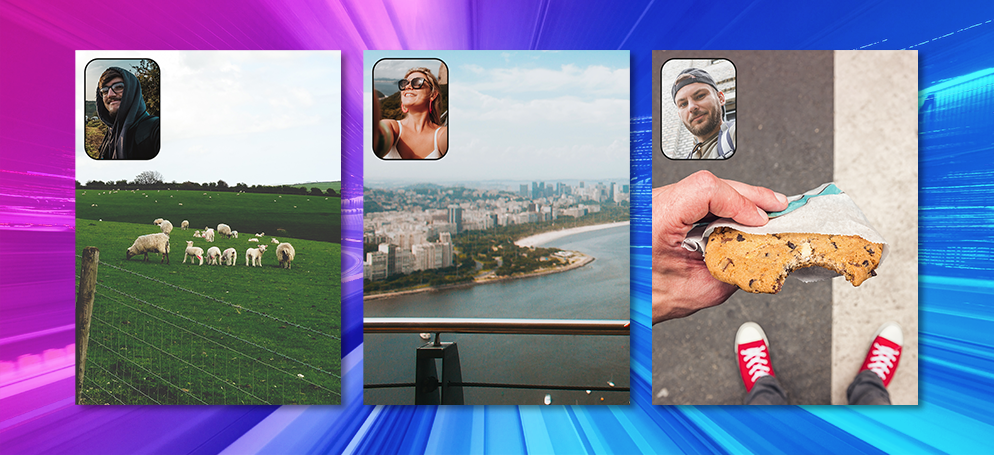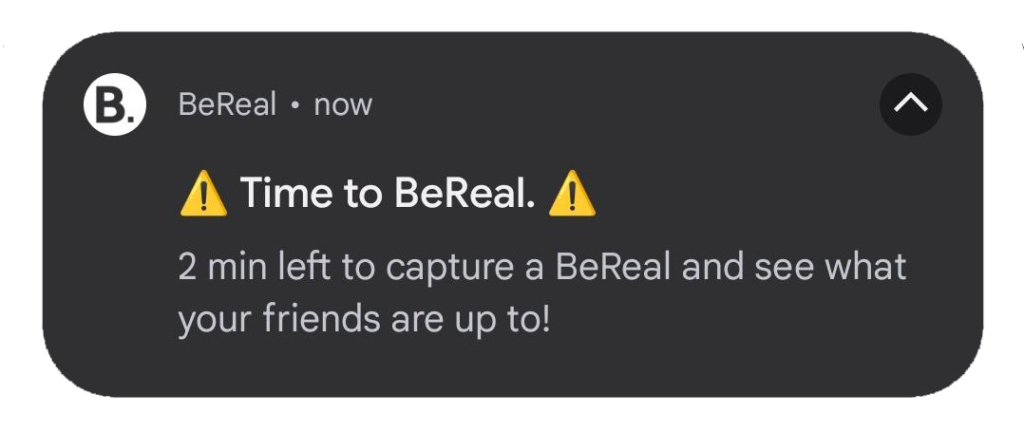
A fast changing world: Should your brand be taking BeReal seriously?
It seems like reality may be making a comeback as the BeReal social media app explodes in popularity. But what is BeReal, how does it work, and should your brand be taking it seriously?
What is BeReal?
BeReal is a social media app which promotes itself as authentic, spontaneous, and candid. Founded by French developers in 2020, it rapidly gained popularity in 2022, after a couple of years of relative obscurity. In part, its popularity can be explained by a paid ambassador programme on college campuses. By mid-2022, the app was clocking around 100,000 daily downloads worldwide, and was among the top five overall iOS apps in around 40 countries. It’s estimated to have about 22 million monthly active users.
How does BeReal work?

BeReal’s main feature is a daily notification that encourages users to share a photo of themselves and their immediate surroundings during a randomly selected two minute window per day. Users are asked to create a post (known as a ‘BeReal’) using mandatory simultaneous photos from both the front and back cameras, to show what they are doing at that moment. The two minute window varies from day to day and is not publicised to users in advance.
It is possible for users to upload a post after the two minute window, but other users will see how late the poster is. Users can also see how many attempts the poster took to take their BeReal, as well as their location. Users are only given one opportunity to delete their BeReal and post another, and it’s not possible to post more than one at a time. If you decide to delete your BeReal of the day, all content becomes locked for the day. Photos of your friends are only visible once you have posted your own photo, to discourage lurking.
On the day they post, users can choose either to make their post visible to friends or the public. If the post is public, anyone on the BeReal app can see it via the Discovery tab. To add friends on BeReal, users can search by username, cross-reference their phone contacts with users, or find friends using the Discovery tab.
The app does not allow any photo filters or other editing and doesn’t show follower counts. The company proudly states that “BeReal won’t make you famous”. BeReal’s co-founder Alexis Barreyat said his objective in creating the app was to foster genuine interactions online. Because most users will be doing something ordinary at the time of the notification – such as working, studying, or running errands – the app portrays a more realistic depiction of our lives than Instagram. However, some critics feel the app crosses the line from authenticity to mundanity.
BeReal has been compared to Wordle – in that both create a daily ritual to share something with friends, and both represent a simple, unobtrusive, and non-addictive way to keep in touch. There’s one Wordle per day, and on BeReal, users are limited to one post per day.
What is behind the rise of BeReal?
BeReal’s explosion in popularity in 2022 is down in large part to a paid ambassador programme on college campuses in target markets. But it’s also been helped by Instagram, which has alienated segments of its audience in the US and UK with its increasing focus on Reels as it seeks to emulate TikTok. Instagram’s algorithm means users are often more likely to see random videos from content creators than photos of their friends, a user experience which is not universally popular.
In general, social media has become less about social connections and online communities, and more about content platforms which often portray unattainable lifestyles. This has left a space on the internet for people simply to connect with one another in a more authentic way – a space which BeReal has successfully managed to fill this year.
The app has a sense of exclusivity which appeals to users. On Instagram, you may follow a 1000 people whose real lives you know little about. On BeReal, you may follow 50 people, and gain an intimate sense of how they are actually spending their days. With its focus on ordinary daily activities, the app may provide reassurance to others who are also stuck at work or carrying out a tedious chore.
The app also demands less of users, with its two minute window per day. You are less likely to spend hours scrolling, precisely because of the nature of its content – for example, a friend working at their desk, or watching Netflix, or doing their grocery shopping.
Overall, BeReal has come along at the right time – when legacy social media apps have become increasingly associated with loneliness and disengagement, and there’s an appetite for something more realistic and relatable.
What countries is BeReal in?
BeReal is internationally available and has language options in English, French, German, Spanish, Japanese, Korean, and Simplified Chinese.
As a French start-up, originally most users were based in France. However, following a marketing drive in the US and UK, the app has grown significantly in those markets. By mid-2022, the app’s biggest markets were:
| Country | Approximate number of downloads |
| United States | 12.3 million |
| United Kingdom | 4.9 million |
| France | 2.1 million |
| The Netherlands | 1.3 million |
| Australia | 1.2 million |
| Canada | 1.2 million |
Reportedly, 55% of the app’s users are in the 16-24 age group and 43% are in the 25-44 age group.
How are competitors responding to BeReal?
With a trending new app gaining traction, competitors are taking notice. Instagram has form for adding new features in response to emerging contenders – Instagram Stories was introduced in response to Snapchat, and Instagram Reels in response to TikTok. To counter BeReal, Instagram has added a feature called Dual, which lets you record with your front and back-facing camera at the same time. Last month, Instagram started testing a feature called ‘Candid Challenges’, where users are prompted to post once per day within two minutes. Snapchat has also rolled out a dual camera feature.
TikTok has launched a BeReal clone called TikTok Now, which is available as a standalone app (largely on iOS) across global markets outside the US. (Within the US, TikTok Now is a feature within the main TikTok app.) TikTok Now sends a notification to users once a day, prompting them to snap a photo or video within a certain timeframe to share with friends, and as with BeReal, users can’t see what their friends have posted until they share their own content. TikTok adds a 10-second video feature — BeReal only allows still images — but otherwise, the two are virtually identical.
The fact that BeReal’s features can be so easily copied highlights a truth in social media – that often, there is no real first mover advantage. The history of social media shows it’s less about innovation, and more about who can do it best. For example, Clubhouse took off like a rocket with its insight that users were looking for audio content – but its features were quickly copied and perfected by bigger rivals, causing it to lose momentum.
BeReal has itself been criticised for copying Frontback, a short-lived app that boasted high profile users such as Jack Dorsey and Ashton Kutcher. Frontback allowed users to take photos with their front and back phone camera at the same time. Twitter was interested in buying the app but the company chose venture capital funding instead – and eventually folded. Like many social media start-ups, Frontback was unable to retain user interest beyond its initial popularity.
Is there a role for brands on BeReal?
When any new platform creates a buzz and starts trending, it’s natural for brands to ask whether they should take notice and join in. However, just because brands can join in, doesn’t necessarily mean they should.
BeReal is a response to an increasing sense that social media suffers from too much editing, advertising, and algorithmic control. Given this, is there really room for brands and marketing to muscle in?
At this stage, BeReal doesn’t allow formal advertising on the app, although this may change as it faces pressure to monetise. This hasn’t stopped some brands from testing approaches on the platform to understand its environment and possibilities. Some of the ways brands could interact with BeReal include:
Share exclusive coupons, information, or releases with your audience
This is a good way to engage with a BeReal audience without requiring extensive planning, since you can’t predict exactly when the platform will send the daily notifications. For example, Chipotle joined the app in April and uses it to share exclusive and reusable promo codes for a certain number of people.
Show the behind-the-scenes of your brand
Given the app’s premise of life without filters, how about showing your brand without filters too? You can invite customers to see life behind-the-scenes of your operation, sharing snapshots of meetings or everyday office or in-store life, and showing the real people behind the company.
Influencer collaborations
Given the scope to capture everyday moments – such as making a cup of coffee, or practising yoga, or applying make-up etc – you can see how influencers could use their daily two minutes to promote products on BeReal, perhaps in a more subtle way than they do on other platforms. However, with the audience’s desire for authentic content, and the app’s positioning as the anti-Instagram, it’s debatable whether these kinds of collaborations will resonate on the platform.
Reference BeReal on your other social media platforms
You don’t necessarily need to be on BeReal to take advantage of the buzz it’s generating. For example, BeReal has popularised the dual camera function – which is why Instagram, Snapchat and others are copying it – so this is a feature you can use in your existing social media channels, to convey a sense of authenticity – as Chelsea FC and Ryanair have done. The ability to create BeReal-inspired content without using BeReal is a way to tap into the conversation.
For brands to be successful on BeReal, they need a unique channel strategy that uses the immediacy of the platform to tell their story. The buzz that BeReal has generated shows there is customer appetite for real and unfiltered content. However, for some brands, ‘letting go’ by publishing authentic, one-shot content might pose a challenge.
On the positive side, BeReal’s accessible production values means you don’t need to blow your budget to get involved. Less positively, it remains to be seen whether BeReal can translate its impact this year into enduring success, and how much of a role there really is for brands on the platform.
. . .
Planning an international digital marketing campaign? With a LIME network made up of over 450 Local In-Market Experts in over 80 countries, Oban can help. Tell us about your requirements by getting in touch.
Oban International is the digital marketing agency specialising in international expansion. Our LIME (Local In-Market Expert) Network provides up to date cultural input and insights from over 80 markets around the world, helping clients realise the best marketing opportunities and avoid the costliest mistakes.